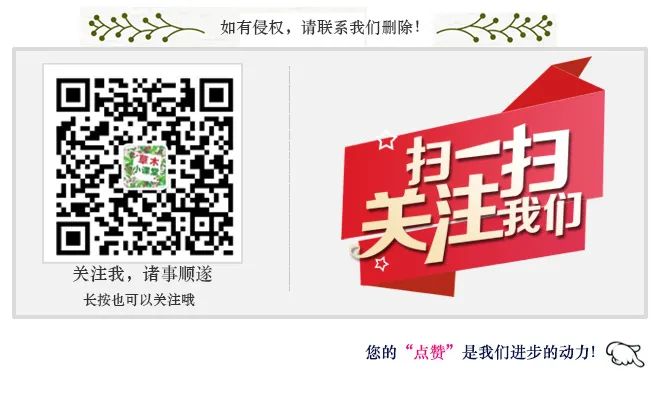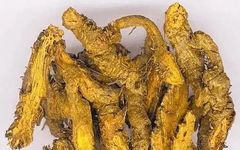| Huang Lian, the name of a traditional Chinese medicine, has the effects of clearing heat, drying dampness, purging fire, and detoxifying. Its taste is extremely bitter, and there is a saying that goes, “A mute eats Huang Lian, unable to express the bitterness,” which aptly describes its flavor. |
What Doctors Say:
It clears heat, dries dampness, purges fire, and detoxifies. Huang Lian is bitter and cold in nature, and it enters the Heart (Xin), Stomach (Wei), Liver (Gan), Large Intestine (Da Chang) meridians. Its main functions include clearing heat and drying dampness, purging fire, and detoxifying. Its primary actions are:
First, it is used for gastrointestinal damp-heat, diarrhea, and vomiting. This herb is extremely bitter and cold, with a stronger ability to clear heat and dry dampness than Huang Qin (Scutellaria baicalensis), particularly effective for clearing damp-heat in the middle jiao (Zhong Jiao) and resolving fire toxicity. It is used for damp-heat obstruction, qi stagnation, abdominal distension, nausea, and vomiting, often combined with Huang Qin, Gan Jiang (Dried Ginger), and Ban Xia (Pinellia ternata) to treat damp-heat diarrhea. In mild cases, it can be used alone effectively. If diarrhea is accompanied by abdominal pain and urgency, it can be combined with Mu Xiang (Aucklandia) as in the Xiang Lian Wan formula. If there is fever with diarrhea, it can be paired with Ge Gen (Pueraria), Huang Qin, and Gan Cao (Licorice) for good therapeutic effects. If there is pus and blood in the stool, it can be combined with Dang Gui (Angelica sinensis), Bai Shao (Paeonia lactiflora), and Mu Xiang.
Second, it is used for excessive heat and irritability, high fever, and restlessness. This herb purges fire and detoxifies, particularly effective for clearing excess heat from the Heart. In cases of excessive heat in the three jiao (San Jiao), high fever, and irritability, it is generally used with Huang Qin, Huang Bai (Phellodendron), and Zhi Zi (Gardenia) as heat-clearing herbs, such as in the Huang Lian Jie Du Tang formula. If the heat pathogen is severe and the yin fluids are damaged, leading to water deficiency and fire excess, causing irritability and insomnia, it is often combined with Huang Lian, Bai Shao, and E Jiao (Donkey-hide Gelatin), as in the Huang Lian E Jiao Tang formula.
Third, it is used for carbuncles, skin ulcers, and swelling and pain in the ears and eyes. This herb clears heat, dries dampness, and detoxifies, used for treating carbuncles and skin ulcers, often combined with Huang Qin, Zhi Zi, and Lian Qiao (Forsythia) as heat-clearing herbs. For skin ulcers, Huang Lian can also be made into an ointment for external application.
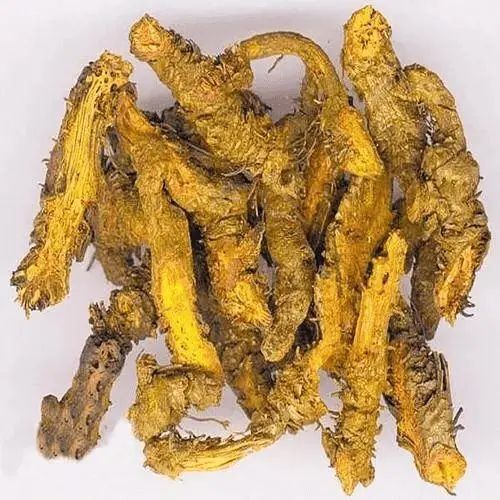
【Pharmacological Knowledge】
【Chinese Medicine Name】Huang Lian (Coptis Rhizoma)
【Alias】Huang Lian, Wang Lian, Wei Lian, Chuan Lian, Ji Zhua Lian.
【English Name】Coptidis Rhizoma.
【Source】The rhizome of the plant Coptis chinensis Franch. from the Ranunculaceae family.
【Plant Morphology】Perennial herb. The rhizome is yellow and often branched. The leaves are all basal, with a leathery texture, trifoliate, the central leaflet with a petiole, ovate-rhombic, deeply lobed, with sharp serrations on the edges, and the lateral lobes are unevenly divided. Flowers are borne in 1-2 clusters; the inflorescence is terminal, with 3-8 flowers, and the involucral bracts are usually 3, lanceolate, and deeply lobed. The sepals are 5, yellow-green, and narrowly ovate; the petals are linear and lanceolate, with a nectar groove in the center; there are many stamens, with the outer stamens slightly shorter or nearly equal in length to the petals; there are 8-12 carpels, free, with short stalks. The fruit is a capsule with 6-12 segments, with fine stalks. The flowering period is from February to April, and the fruiting period is from March to June.
【Distribution】Grows in cool, damp, shaded areas in mountainous regions, wild in valleys at altitudes of 1000-1900 meters. Cultivated in high-altitude cool mountainous areas, particularly in Sichuan.
【Harvesting and Processing】Harvested in autumn, removing the fibrous roots and soil, dried, and removing residual fibrous roots.
【Herb Characteristics】Often clustered, usually curved, resembling chicken feet, with single rhizomes 3-6 cm long and 0.3-0.8 cm in diameter. The surface is grayish-yellow or yellow-brown, rough, with irregular nodular protrusions, fibrous roots, and remnants of fibrous roots. Some segments are smooth like stems, commonly referred to as “crossing the bridge.” The upper part often retains brown scale leaves, and the tip usually has remnants of stems or petioles. The texture is hard, with an uneven cross-section; the bark is orange-red or dark brown, and the wood is bright yellow or orange-yellow, arranged radially, with some hollow pith. It has a faint odor and an extremely bitter taste.
【Nature and Taste】Cold in nature, bitter in taste. It enters the Heart, Spleen, Stomach, Liver, Gallbladder, and Large Intestine meridians.
【Functions and Actions】Clears heat, dries dampness, purges fire, and detoxifies. It belongs to the category of heat-clearing herbs, specifically those that clear heat and dry dampness.
【Clinical Applications】Dosage is 2-5 grams, decocted for oral administration. It is used to treat damp-heat fullness, vomiting, acid regurgitation, diarrhea, jaundice, high fever with delirium, excessive heart fire, blood heat with vomiting or nosebleeds, red eyes, toothache, diabetes, and carbuncles. For external use, apply appropriately for eczema, skin ulcers, and ear discharge.
【Pharmacological Research】Animal experiments have shown that berberine has antibacterial, antiviral, and antiparasitic effects, promotes bile secretion, has anti-diarrheal, anti-inflammatory, and anti-cerebral ischemia effects, has antimicrobial properties, lowers blood pressure, protects against myocardial ischemia and infarction, prevents arrhythmias, inhibits the central nervous system, stops diarrhea, has anti-ulcer effects, promotes bile secretion, lowers blood sugar, inhibits DNA synthesis, and inhibits platelet aggregation.
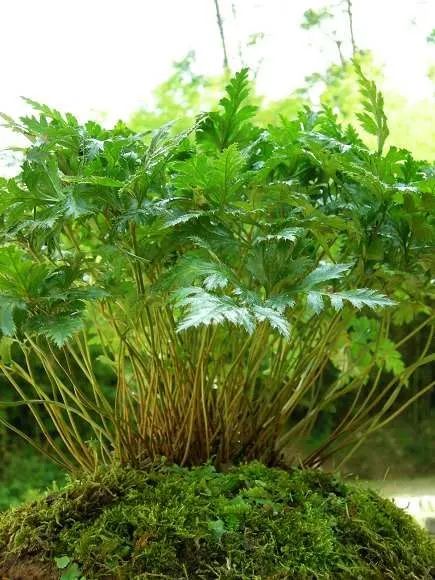
【Chemical Components】Contains berberine, as well as coptisine, methylcoptisine, palmatine, jatrorrhizine, epiberberine, and other alkaloids. The authenticity of Huang Lian can be identified using nuclear magnetic resonance hydrogen spectroscopy. Berberine is the main active component in Huang Lian.
【Contraindications】Use with caution in cases of stomach deficiency with vomiting, spleen deficiency with diarrhea, and nocturnal kidney leakage.
【Formulation References】For reference only
1. For pain in the stomach due to excessive consumption of hot foods, or persistent vomiting: Huang Lian 18 grams, Gan Cao (Honey-fried Licorice) 3 grams. Prepare one dose, using one large cup of water, decoct to 70%, strain, and take warm. (From “Heart Medicine Collection”)
2. For stomach pain unresponsive to other treatments, use a cold remedy for heat: Huang Lian 18 grams, Fu Zi (Processed Aconite) 3 grams. Cut finely. Prepare one dose, adding three slices of fresh ginger and one jujube, using one and a half cups of water, decoct until one cup remains, strain, and take warm. (From “Medical Truth”)
3. For persistent vomiting due to damp-heat syndrome, day and night: Huang Lian 0.9-1.2 grams, Su Ye (Perilla Leaf) 0.6-0.9 grams, decoct and take immediately. (From “Damp-Heat Disease Chapter”)
4. For hemorrhoids: Huang Lian 60 grams, decoct into a paste, then add equal parts of Glauber’s salt and 3 grams of borneol. Apply to hemorrhoids for immediate relief. (From “Danxi’s Key to Treatment”)
5. For oral ulcers: Huang Lian, Pu Xiao (Sodium Sulfate), and Bai Fan (Alum) each 15 grams, with 30 grams of mint leaves. Grind into a coarse powder, place in the gallbladder of a yellow cow in winter, hang in the wind for two months, then take down. When encountering oral ulcers, grind finely and apply to relieve heat and saliva, leading to recovery. (From “Complete Book of Jing Yue”)
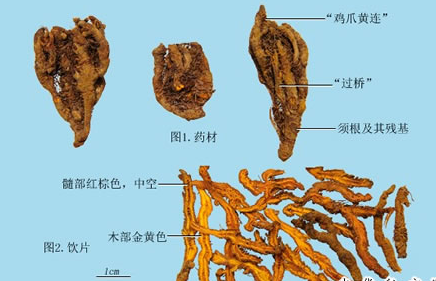
【Formula Composition】
【Formula Name】Huang Lian Decoction, from Han Dynasty’s “Treatise on Febrile Diseases”.
【Composition】Huang Lian 3 taels (9 grams), Ban Xia 1/2 sheng (9 grams), Gan Cao, Gan Jiang, Gui Zhi each 1 tael (9 grams), Ren Shen 2 taels (6 grams), and Da Zao 10 pieces (4 pieces).
【Usage】Decoct in water for oral administration.
【Functions】Balances cold and heat, harmonizes the stomach, and descends rebellious qi.
【Indications】Heat above and cold below, symptoms include chest and abdominal fullness, irritability, qi counterflow with nausea, abdominal pain, or borborygmus and diarrhea, with a white, slippery tongue coating and wiry pulse.
【Clinical Cases】Mainly used in clinical practice for treating chronic gastritis, gastroesophageal reflux disease, etc.
1. Atrophic gastritis: Huang Lian Decoction with modifications was used to treat 54 cases of atrophic gastritis, composed of Huang Lian 5 grams, Gan Jiang, Gui Zhi, Fa Ban Xia, and Gan Cao each 10 grams, Dang Shen 30 grams, and 7 pieces of Da Zao. Modifications: For those with spleen and stomach deficiency, Huang Lian is omitted, and Bai Zhu (Atractylodes) and Fu Ling (Poria) are added; for those with qi stagnation, Su Geng (Perilla Stem), Fo Shou (Bitter Orange), and Xiang Fu (Cyperus) are added; for liver-stomach disharmony, Chai Hu (Bupleurum), Bai Shao, Zhi Ke (Bitter Orange), and Yu Jin (Curcuma) are added; for damp-heat obstruction, Hou Po (Magnolia Bark) and Huo Xiang (Agastache) are added; for stomach heat accumulation, Zhi Zi and Huang Qin are added; for blood stasis, Chuan Lian Zi (Melia) and Yan Hu Suo (Corydalis) are added; for mixed cold and heat, Bi Cheng Qie (Zanthoxylum) and Wu Zhu Yu (Evodia) are added. One dose per day, decocted for oral administration. A 30-day course of treatment, with two courses in total. Clinical symptoms and signs disappeared or significantly improved, with gastroscopy showing active inflammation of the gastric mucosa basically disappeared, chronic inflammation improved, gland atrophy, intestinal metaplasia, and atypical hyperplasia disappeared or reduced by two grades or more (including two grades) for significant efficacy; clinical symptoms and signs significantly reduced, with gastroscopy showing the range of mucosal lesions reduced by more than half, and pathological examination showing acute and chronic inflammation reduced, gland atrophy, intestinal metaplasia, and atypical hyperplasia reduced by one grade for effective; those not meeting effective standards but not worsening were deemed ineffective; clinical symptoms worsening, with gastroscopy showing mucosal lesions worsening, gland atrophy, intestinal metaplasia, and atypical hyperplasia increasing by one grade or more were deemed deterioration. Results: Significant efficacy in 20 cases, effective in 29 cases, ineffective in 4 cases, and deterioration in 1 case, with a total effective rate of 90.7%. (From “Fujian Traditional Chinese Medicine”, 2007, Issue 3)
2. Gastroesophageal reflux disease: Modified Huang Lian Decoction was used to treat 38 cases of gastroesophageal reflux disease, with the control group receiving 40 mg of pantoprazole enteric-coated capsules once daily and 10 mg of domperidone three times daily. The treatment group received the modified Huang Lian Decoction in addition to the control group treatment. Both groups were treated for 4 weeks, and clinical symptoms were followed up and compared with gastroscopy results after 4 weeks. Results: Clinical efficacy comparison: The treatment group had 25 cases cured, 12 effective, and 1 ineffective, while the control group had 11 cured, 14 effective, and 7 ineffective, with the treatment group outperforming the control group (clinical symptom disappearance was considered cured; significant improvement or basic disappearance of symptoms was considered effective; no significant improvement or worsening was considered ineffective). Endoscopic efficacy comparison: The treatment group had 20 cases cured, 16 effective, and 2 ineffective, while the control group had 7 cured, 17 effective, and 8 ineffective (endoscopic disappearance of esophagitis was considered cured; improvement of esophagitis by ≥1 grade was considered effective; no change or worsening was considered ineffective). (From “Chinese Journal of Experimental Formulas”, 2010, Issue 6)
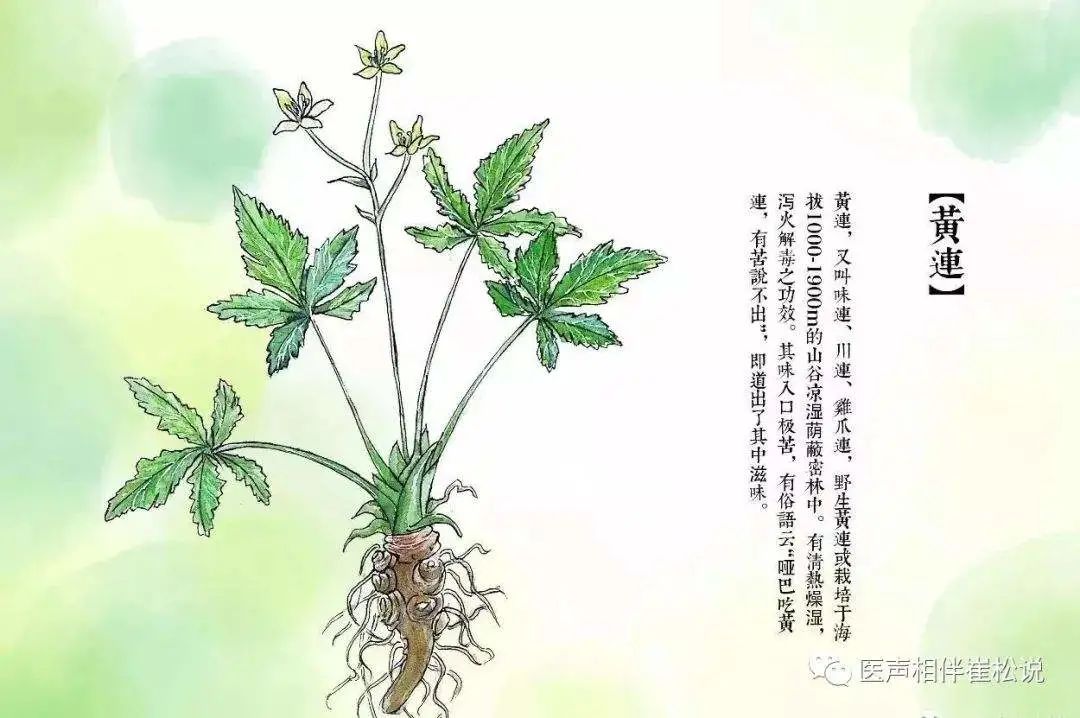
【Formula Analysis】This formula is derived from Ban Xia Xie Xin Tang, removing Huang Qin and adding Gui Zhi, effectively treating the syndrome of heat above and cold below, with disordered ascending and descending. Huang Lian in the formula is bitter and cold, clearing heat from the chest while harmonizing stomach qi; Gan Jiang and Gui Zhi are warm and dispersing, dispelling cold and alleviating pain; Ban Xia harmonizes the stomach, descends rebellious qi, and relieves nausea, while Ren Shen, Da Zao, and Gan Cao tonify qi and strengthen the spleen, alleviating urgency and pain. The entire formula clears the upper and warms the lower, with pungent opening and bitter descending, combining tonification and purgation, but primarily focusing on pungent opening and warming.
This formula, like Ban Xia Xie Xin Tang, belongs to the category of pungent opening and bitter descending, with the function of harmonizing the stomach and dispersing masses to relieve fullness, treating the syndrome of mixed cold and heat, and disharmony of stomach qi leading to fullness, vomiting, and diarrhea. Although the two formulas differ by only one herb, Ban Xia Xie Xin Tang includes Huang Qin, thus leaning towards bitter descending and focusing on purging heat and relieving fullness, while Huang Lian Decoction, replacing Huang Qin with Gui Zhi, leans towards pungent opening and focuses on balancing cold and heat.
Huang Lian Decoction is clinically used to treat exterior pathogens transmitting to the interior, damaging the spleen and stomach, leading to the syndrome of heat above and cold below, with vomiting and abdominal pain as key diagnostic points.
【Modern Research】Modern studies have shown anti-arrhythmic effects, positive inotropic and diuretic effects, vasodilation, and improvement of microcirculation.
Huang Lian Decoction contains Gan Jiang, Ban Xia, Ren Shen, and Gan Cao, along with Gui Zhi and Da Zao, balancing cold and heat, alleviating nausea and pain.
| =====Previous Classics======Traditional Chinese Medicine – The Efficacy and Functions of Ji Nei JinTraditional Chinese Medicine – The Efficacy and Functions of Zi Ling ZhiTraditional Chinese Medicine – The Efficacy and Functions of Huai JiaoTraditional Chinese Medicine – The Efficacy and Functions of Sang Bai PiThe 6 Benefits and 5 Contraindications of Drinking Western Ginseng Tea, Recommended to Read Before DrinkingAllergic Rhinitis is Quite Painful, Why Does it Often Accompany Asthma?Which Oil is More Suitable for Home Cooking: Soybean Oil, Rapeseed Oil, or Peanut Oil? A Chef’s Guide to Choosing OilThe Benefits and Contraindications of Passion Fruit: Who Should Not Eat Passion Fruit |
